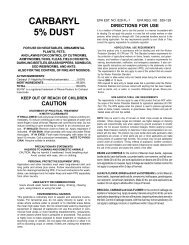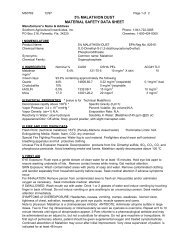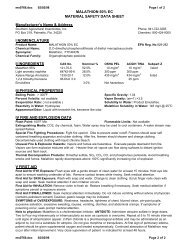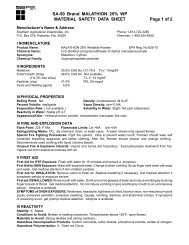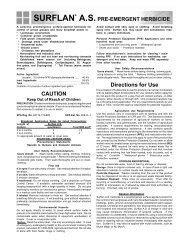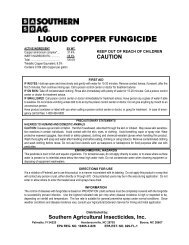cygon2E label for EPA - Southern Ag
cygon2E label for EPA - Southern Ag
cygon2E label for EPA - Southern Ag
Create successful ePaper yourself
Turn your PDF publications into a flip-book with our unique Google optimized e-Paper software.
CYGON 2E<br />
DIMETHOATE SYSTEMIC INSECTICIDE<br />
For commercial ornamental production in nurseries. Not <strong>for</strong> residential use.<br />
For the control of Leaf miners, Aphids, and certain other insects on Ornamentals and Vegetables.<br />
ACTIVE INGREDIENT:<br />
Dimethoate [O,O-dimethyl S-(N-methylcarbamoylmethyl) phosphorodithioate].. 23.0%<br />
INERT INGREDIENTS........................................................................................... 77.0%<br />
TOTAL................................................................................................................ 100.0%<br />
Contains Petroleum distillate.<br />
Contains 2 lbs. Dimethoate per gallon CygonR Reg. TM of American Cyanamid Co.<br />
KEEP OUT OF REACH OF CHILDREN<br />
WARNING - AVISO<br />
Si Usted no entiende la etiqueta, busque a alguien para que se la explique a Usted en detail.<br />
(If you do not understand this <strong>label</strong>, find someone to explain it to you in detail.)<br />
0 51538 25414 4<br />
STATEMENT OF PRACTICAL TREATMENT<br />
ORGANOPHOSPHATE<br />
If Swallowed: Call a physician or Poison Control Center immediately. Gastric lavage is usually indicated. Do not induce vomiting.<br />
Vomiting may cause aspiration pneumonia. Do not induce vomiting or give substances by mouth to an unconscious person.<br />
If Inhaled: Remove victim to fresh air. Assist respiration if indicated.<br />
If On Skin: Promptly wash contaminated skin with soap and water<br />
If in Eyes: Immediately flush eyes with plenty of water. Get medical attention if irritation persists.<br />
NOTE TO PHYSICIAN: This product may cause cholinesterase inhibition. Atropine is antidotal.<br />
See Inside of <strong>label</strong> <strong>for</strong> Additional Precautionary Statements.<br />
SOUTHERN AGRICULTURAL INSECTICIDES, INC.<br />
Palmetto, FL 34220 Hendersonville, NC 28793 Boone, NC 28607<br />
<strong>EPA</strong> Reg. No. 829-251 J6 <strong>EPA</strong> EST. NO. 829-FL-1<br />
Net Contents Liquid: 1 Gallon ( 3.785 liters)
PRECAUTIONARY STATEMENTS<br />
HAZARDS TO HUMANS AND DOMESTIC ANIMALS<br />
WARNING<br />
VAPOR HARMFUL<br />
HARMFUL OR FATAL IF SWALLOWED<br />
CONCENTRATED MATERIAL CAUSES EYE IRRITATION<br />
Avoid breathing vapor or spray mist. Avoid contact with skin or eyes. Use only with adequate ventilation. Do not contaminate food. Do not use in<br />
homes. Rinse spills on outside of container after use.<br />
Do not contaminate feed and foodstuffs, drinking fountains, litter and feed troughs. Do not use in milk processing rooms, including milk houses and<br />
milk storage rooms. Do not apply this product by aerial application.<br />
PERSONAL PROTECTIVE EQUIPMENT<br />
Some materials that are chemical-resistant to this product are listed below. If you want more options, follow the instructions <strong>for</strong> category G on an<br />
<strong>EPA</strong> chemical resistance category selection chart.<br />
Applicators and other handlers must wear:<br />
1. Coveralls over short-sleeved shirt and short pants 2. Chemical-resistant gloves, such as barrier laminate or viton<br />
3. Chemical-resistant footwear plus socks 4. Protective eyewear<br />
5. Chemical-resistant headgear <strong>for</strong> overhead exposure 6. Chemical-resistant apron when cleaning equipment<br />
Mixers and loaders must wear:<br />
1. Coveralls over short-sleeved shirt and short pants 2. Chemical-resistant gloves, such as barrier laminate or viton<br />
3. Chemical-resistant footwear plus socks 4. Protective eyewear<br />
5. Chemical-resistant headgear 6. Chemical-resistant apron when mixing or loading<br />
7. For exposures in enclosed areas, use a respirator with either an organic vapor removing cartridge with a refilter approved <strong>for</strong> pesticides<br />
(MSHA/NIOSH approval number prefix TC-23C), or a canister approved <strong>for</strong> pesticides (MSHA/MIOSH approval number prefix TC-14G).<br />
For exposures outdoors, use a dust/mist filtering respirator (MSHA/NIOSH approval number prefix TC-21C). Discard clothing and other absorbent<br />
materials that have been drenched or heavily contaminated with this product’s concentrate. Do not reuse them. Follow manufacturer’s instructions<br />
<strong>for</strong> cleaning and maintaining PPE. If no such instructions <strong>for</strong> washables, use detergent and hot water. Keep and wash PPE separately from other<br />
laundry.<br />
USER SAFETY RECOMMENDATIONS<br />
Users should:<br />
1. Wash hands be<strong>for</strong>e eating, drinking, chewing gum, using tobacco or using the toilet.<br />
2. Remove clothing immediately if pesticide gets inside. Then wash thoroughly and put on clean clothing.<br />
3. Remove PPE immediately after handling this product. Wash the outside of gloves be<strong>for</strong>e removing. As soon as possible, wash thoroughly<br />
and change into clean clothing.<br />
ENVIRONMENTAL HAZARDS<br />
This product is toxic to wildlife and aquatic invertebrates. For terrestrial uses, do not apply directly to water, or to areas where surface water is<br />
present, or to intertidal areas below the mean high water mark. Runoff from treated areas may be hazardous to aquatic organisms in neighboring<br />
areas. Do not contaminate water by cleaning of equipment or disposal of wastes.<br />
This pesticide is highly toxic to bees exposed to direct treatment or residues on blooming crops or weeds. Do not apply this product or allow it to drift<br />
to blooming crops or weeds if bees are visiting the treatment area. Apply this product only as specified on this <strong>label</strong>.<br />
PHYSICAL AND CHEMICAL HAZARDS<br />
COMBUSTIBLE DO NOT USE, POUR, SPILL OR STORE NEAR HEAT OR OPEN FLAMES.
DIRECTIONS FOR USE<br />
It is a violation of Federal Law to use this product in a manner inconsistent with its <strong>label</strong>ing.<br />
Do not apply this product in a way that will contact workers or other persons, either directly or through drift. Only protected handlers may be in the area<br />
during application. For any requirements specific to your State or Tribe, consult the agency responsible <strong>for</strong> pesticide regulation.<br />
AGRICULTURAL USE REQUIREMENTS<br />
Use this product only in accordance with its <strong>label</strong>ing and with the Worker Protection Standard,40 CFR part 170. This Standard contains requirements<br />
<strong>for</strong> the protection of agricultural workers on farms, <strong>for</strong>ests, nurseries, and greenhouses, and handlers of agricultural pesticides. It contains<br />
requirements <strong>for</strong> training, decontamination, notification, and emergency assistance. It also contains specific instructions and exceptions pertaining to<br />
the statements on this <strong>label</strong> about personal protective equipment (PPE), and restricted-entry interval. The requirements in this box only apply to uses<br />
of this product that are covered by the Worker Protection Standard.<br />
Do not enter or allow worker entry into treated areas during the restricted entry interval of 48 hours.<br />
PPE required <strong>for</strong> early entry to treated areas that is permitted under the Worker Protection Standard and involves contact with anything that has been<br />
treated, such as plants, soil, or water, is:<br />
1. Coveralls over short-sleeved shirt and short pants.<br />
2. Chemical-resistant gloves, such as barrier laminate or viton<br />
3. Chemical-resistant footwear plus socks<br />
4. Protective eyewear<br />
5. Chemical-resistant headgear <strong>for</strong> overhead exposure<br />
NON-AGRICULTURAL USE REQUIREMENTS<br />
The requirements in this box apply to uses of this product that are NOT within the scope of the Worker Protection Standard <strong>for</strong> agricultural pesticides<br />
( 40 CFR Part 170 ). The WPS applies when this product is used to produce agricultural plants on farms, <strong>for</strong>ests, nurseries, or greenhouses. Keep<br />
children and pets off treated area until spray has dried.<br />
SA-50 Cygon 2E Dimethoate Systemic Insecticide controls certain soft bodied insects such as aphids, leaf miners, mites, thrips and scales on ornamentals<br />
and certain vegetables as listed below.<br />
Mix this material with water, using the rates shown below. The addition of a spreader-sticker at the proper <strong>label</strong> rate will aid in spray retention. Spray<br />
plants in a manner that will uni<strong>for</strong>mly coat upper and lower surfaces of foliage. Applications should be started as soon as insects are observed and<br />
repeated at 7 to 10 day intervals as long as needed. On vegetables listed below, the interval in days between the last application of this product and<br />
harvest is shown in parenthesis after each crop.
ORNAMENTAL PLANTS GROWN IN OUTDOOR NURSERIES<br />
When applying to ornamentals spray until wet and make full cover sprays at the specified intervals. For the proper timing <strong>for</strong> the control of<br />
specific pests, consult your state agricultural extension service.<br />
AZALEAS: For the control of Leaf Miners, Lace Bugs, Mites, Tea Scale, and White Flies mix 1 Quart per 100 gallons (2 teaspoonfuls per gallon) of<br />
water.<br />
BIRCH: For the control of aphids and leafminers mix 1 Pint per 100 gallons (1 teaspoonful per gallon) of water. For leafminers, apply when leaves<br />
are expanded ( about mid-May) and repeat in early July. PAINT METHOD: To control leafminers, an application to the bark can be made. The<br />
material will be absorbed and carried by the sap up to the leaves. To apply, paint a band of undiluted SA-50 Cygon 2E Dimethoate Systemic<br />
Insecticide around the trunk of the tree below the lowest branches. The width of the band must be equal to the thickness of the trunk at that<br />
location ( maximum 6"). Make first treatment at bud break. Weather conditions are important <strong>for</strong> the correct timing of treatment. If weather is<br />
warm and buds break fast than apply when green tips are visible. If weather is cold apply when leaves are almost completely unfolded. Make a<br />
second application 6 weeks after the first. Do not make more than two applications per season. Newly planted trees or those with trunks less<br />
than 1 inch in diameter may be injured. Do not apply to the trunk of any other tree or severe injury may result.<br />
BOXWOOD: For the control of Leaf Miners, Mealy Bugs, and Mites mix 1 Quart per 100 gallons (2 teaspoonfuls per gallon) of water.<br />
CAMELLIAS: For the control of aphids, camellia scale, mites, and tea scale mix 1 Quart per 100 gallons (2 teaspoonfuls per gallon) of water.<br />
FOLIAR SPRAY: Apply 2 sprays 6 weeks apart the first year followed by annual applications after growth begins in the spring.<br />
SOIL DRENCH: Apply as a soil drench around the base of plants in early spring. Mix 4 tablespoonfuls per gallon of water and apply 1 gallon of<br />
solution per plant up to 6 feet tall. For larger plants, the rate should be increased proportionately.<br />
EUONYMUS : For the control of Aphids and Scale mix 2 Quarts per 100 gallons (4 teaspoonfuls per gallon) of water.<br />
GLADIOLUS : For the control of Aphids and Thrips mix 1 Quart per 100 gallons (2 teaspoonfuls per gallon) of water.<br />
HEMLOCK: For the control of Mites and Scale mix 1 Quart per 100 gallons (2 teaspoonfuls per gallon) of water.<br />
JUNIPER: For the control of Aphids, Leafhoppers, Mites, and Thrips mix 2 Quarts per 100 gallons (4 teaspoonfuls per gallon) of water.<br />
ROSES: For the control of Aphids, cucumber beetle, leafhoppers, mites and thrips, mix 1 pint per 100 gallons (1 teaspoonful per gallon) of water and<br />
apply to the point of run-off.<br />
VEGETABLES<br />
Use the higher rate if insect infestation is high and use a lower rate if pest level is low.<br />
Use the rate given below with 40-100 gallons of water per acre.<br />
The interval in days between the last application of this product and harvest is shown in parentheses after each crop.<br />
BEANS (2) - 1-2 Pints per acre- Aphids, Leafhoppers, Leaf Miners, Mites, Mealy Bugs<br />
BROCCOLI (7), CAULIFLOWER (7), LEAF LETTUCE (14), SPINACH (14), COLLARDS (14), KALE (14), TURNIP (14), MUSTARD (14), SWISS CHARD<br />
(14), ENDIVE (14) - 1 Pint per acre - Aphids, Leafhoppers, Leaf Miners<br />
MELONS (3) - 1-2 Pints per acre - Aphids, Leafhoppers, Leaf Miners<br />
PEAS, (2), POTATOES (2), TOMATOES (7) - 1-2 Pints per acre - Aphids, Leaf Miners<br />
NOTE: Do not make more than one (1) application per season on peas.<br />
This pesticide is highly toxic to bees in treatment area. Do not apply to peas (lentils), beans (lupine), or melons if bees are visiting the areas to be treated<br />
when crop or weeds are in bloom.<br />
STORAGE AND DISPOSAL<br />
Do not contaminate water, food, or feed by storage and disposal.<br />
Storage: Store product in original container in a cool, dry, locked place out of reach of children and pets.<br />
Pesticide Disposal : Wastes resulting from the use of this product may be disposed of on site or at an approved waste facility.<br />
Container Disposal : Triple rinse (or equivalent). Then offer <strong>for</strong> recycling or reconditioning, or puncture and dispose of in a sanitary landfill, or<br />
incinerate, or if allowed by State and local authorities, by burning. If burned, stay out of smoke.<br />
Buyer assumes all risks of use, storage or handling of this material not in strict accordance with the instructions and precautions given herewith.



